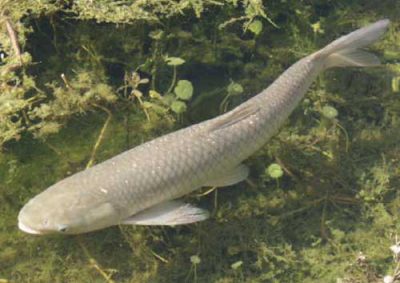Collaborative effort held to sample for grass carp in Sandusky River

Grass Carp. Photo from ODNR.

FREMONT, Ohio – Fisheries biologists from multiple agencies recently conducted a project on the Sandusky River to assess the ability to capture grass carp, according to the Ohio Department of Natural Resources (ODNR).
Crews from the ODNR Division of Wildlife worked with Michigan DNR, Department of Fisheries and Oceans Canada, U.S. Geological Survey, New York Department of Environmental Conservation (DEC) and the University of Toledo for two days of sampling looking for grass carp, in conjunction with aquatic invasive species sampling in Sandusky Bay conducted by the U.S. Fish and Wildlife Service.
The crews sampled Aug. 29-30, 2017 which included the coordinated use of multiple electrofishing vessels, gill nets and fyke nets to collect adult and juvenile carp in the Sandusky River. Over the two days, eight fish were collected using the refined sampling techniques. Although present in the system, grass carp populations are considered to be low, and this week’s action reinforces this conclusion.
This week’s testing of various sampling methods along with ongoing assessment has helped to identify alternative techniques to increase capture efficiencies for a planned, large-scale sampling event to be held in 2018. This is one part of a structured and measured approach to better understand and address grass carp in Lake Erie.
The increased knowledge of grass carp in western Lake Erie gained through this research allows natural resource agencies, working through the Great Lakes Fishery Commission, to collaboratively develop science-based management approaches and evaluate the effectiveness of different actions and strategies.
The grass carp is an invasive species in the Great Lakes region and is one of four species commonly identified as Asian carp. All species of Asian carp do not have the same negative ecological effects. Grass carp present significantly different risks to the Lake Erie ecosystem compared to the highly invasive bighead carp and silver carp.
An adult grass carp commonly weighs more than 20 pounds and can grow up to 48 inches in length. The fish are primarily herbivorous, consuming large quantities of aquatic vegetation, and they can affect fish communities primarily through habitat modification.
Grass carp were actively stocked in private ponds in many states as early as the 1970s, and some have escaped. Grass carp have been detected in Lake Erie since the mid-1980s. Recent efforts to collect fish have resulted in low catch rates, indicating that fish are present in low densities. Although there is currently no evidence of negative ecological impact to the Lake Erie ecosystem attributed to grass carp, this study furthers research on this topic and can also prove useful in providing methods to study other species.
ODNR ensures a balance between wise use and protection of our natural resources for the benefit of all. Visit the ODNR website at ohiodnr.gov.






